If you wander around the City your eye will inevitably be drawn by the gleaming tall modern office blocks or the hulking Victorian facades (all listed) behind which there tend to be new offices. But of course the City has existed for almost 2000 years and if you know where to look there are lots of little remnants that have survived both the Great Fire and the Blitz - mostly now represented by "pocket parks", bits of walls that survived because they were incorporated into houses and then uncovered when the houses were bomb damaged, and the proliferation of churches from times when the City had a Christian population, not just commuting office workers.
So to start, a pocket park - Postman's Park - named because nearby used to be the old Post Office HQ. It is a small secluded spot often used by City workers to eat a lunchtime sandwich or have a fag.
A reminder of the perils of the theatre in the days before electric lighting....
Nearby in Noble Street is a surprisingly long stretch of old wall where the old Roman garrison fort once stood
This is what is left of St Alban Wood Street. This was rebuilt after the Great Fire by Wren, but succumbed to the Blitz and was not restored, leaving just the Tower surviving which stands in the middle of Wood Street. It is now a very distinctive private residence. Not a conventional house!
Love Lane is worth a mention just for the name. You would like it to have some charming romantic connotation, but it is simply the medieval red light district!
The remains of St Alpahge London Wall. This church actually took over the crumbling remains of the medieval priory and hospital of Elsing Spital that had been fallen to the dissolution of the monasteries by Henry VIII. Unlike every thing else, the church wasn't bombed out in the 1940s but demolished in the 1920s, apart from the original tower. Which says a lot for its medieval builders.
Down at street level you can see how much of the wall remains
Now, in the middle of the Barbican centre is the one real working church in the City, St Giles Without Cripplegate. Although it has had bits of rebuilding done, it is one of the few medieval churches that survived the Great Fire intact. Oliver Cromwell was married here, and Shakespeare's nephew buried here.
This is St Mary le Bow with its Wren tower.
The "Bow" refers to the "bows", or arches, in the Norman crypt, which you can still go down into
The 18th century interior is lovely too.
The church is on Cheapside, the busiest street in the medieval City and still the City's main shopping street. Mostly it is now new swish shopping developments, but below are three small shops that date from 1687.
"Cheapside" derives from the old English word for market - cheap. Most of the side streets were also laid out in Saxon times and are still named after the original goods that would have been traded out of them in medieval England - Poultry, Milk Street, Ironmonger Lane, Honey Street, Bread Street.
On Cheapside there is another tiny garden totally shaded by a huge plane tree on the site of another church that didn't survive the Great Fire, St Peter Westcheap. It is a rather dismal spot now, very tiny, dark because of the tree and I was the only person there not chain smoking. All these little parks and churchyards have discovered a new use as places to develop lung cancer in peace.
Now below you may think you see a church, but it is actually a solicitor's offices. The tower is indeed from a church - it was St Olave Jewry rebuilt by Wren after the Great Fire but closed in 1888 and redeveloped, but Wren's tower was retained and incorporated into an office block. Pretty impressive entrance.
Here is a spot I never knew existed despite working in the City for nearly 30 years. It is a little cul-de-sac called Fredericks Place and it is a throwback to the old City, ie when it was already a commercial centre, but just hasn't been knocked down in favour of bigger more fashionable offices.
It's most famous former office worker is a young Benjamin Disraeli, who was an articled clerk in a firm of lawyers here in the 1820s.
Another slightly less well known worker who also has a plaque here is Edwin Waterhouse, who won't mean much to you but he established an accountancy firm which is now the global beast that is Price Waterhouse Coopers.
And a plaque to a much earlier, and darker, period of history in the neigbouring street of Old Jewry. Here stood the Great Synagogue as medieval London had a significant Jewish population, often involved in money lending because the Church decided that was not a fit profession for Christians. A bit like Muslims still pretend, while actually benefitting from other people carrying on the trade, just as the early Christians did from the Jews (and their taxes!). Twas ever thus. Hypocrisy is truly one of the oldest human traits. Of course the Jews did very well from carrying out other people's sins for them, which was resented. Their rights were restricted in the late 13th century so that they couldn't own land, then they couldn't practice money lending and finally this all led to the now impoverished Jews being banished from England in 1290. The Nazis in the 1930s were treading well worn ground. At least in England, having been allowed to return in 1656, a Jew could become prime minister (twice) in the 19th century in the form of the aforementioned Mr Disraeli.
Anyway, that explains why there was a great synagogue, and why it disappeared such a very long time ago.
And here is the church of St Lawrence Jewry, another Christopher Wren rebuild
And here is one of the City's most historic, but lesser known, sights, the Guildhall. This is the most attractive bit. It has been adapted a great deal over the centuries, but parts of it date back to the 1400s and....
....its art gallery below sits right on the very limited remains of the Roman amphitheatre. Unfortunately Covid restrictions meant I couldn't just visit without having pre-booked. A shame as it is a very nice art collection of mainly London scenes.
The less said about the 1960s concrete Guildhall extension to the left, the better.😱
And here is another garden occupying the site of a former church, St Mary the Virgin Aldermanbury. Another medieval church, destroyed in the Great Fire, rebuilt by Wren destroyed again by the luftwaffe, this time not rebuilt, but, extraordinarily, its remains were packed off to Missouri!
I particularly like this livery company building with its modern office backdrop. It represents another long gone trade of significance. This is the Girdlers' Livery Hall and yes they controlled the financially important medieval trade in girdles.
The Keats at the Globe pub, a watering hole that I have occasionally frequented. Yes the poet John Keats was born in his father's pub here (although not this actual building)
So now I had a break for lunch with my best mate at Swedish restaurant. Very nice.
And then back on the road and more churches. St Mary Aldermary, a very distinctive church. Yes another Wren rebuild, but this one in Gothic rather than classical style.
But inside lies its true glory - this fan-vaulted plaster ceiling.
And onto the next Wren church down the road, St James Garlickhythe (currently under renovation). This was once almost on the Thames shoreline (hence "hythe" - a landing place)
St Michael Paternoster Royal - yes another Wren church and very like the last one in appearance!
Blackfriars Bridge
Another livery hall - the Apothecaries Hall.
And another small overshadowed garden, St Ann Blackfriars, a puritan church that was built after the demolition of the Augustinian monastery (hence the Black Friars), but didn't make the cut when it came to rebuilding after the Great Fire (88 were burnt down and 51 rebuilt).
And this little bit of wall is all that remains from the old monastery!
The attractive Stationers Hall, or to give it its proper title, the Livery Hall of the Worshipful Company of Stationers and Newspaper Makers. You can see why that wouldn't fit easily on a sign....
Amen Corner, a quiet cul-de-sac of 17th and 18th century houses which are home to many of the staff and clergy of nearby St Paul's Cathedral.
The Cutlers Hall, for the association that controlled the trade in swords and surgical instruments.
This is what is left of Christ Church Newgate, bombed out in the Blitz. The tower has been converted into a private residence and the nave is now a rose garden, a much more useful addition to the City than rebuilding the Wren church, of which as you will have seen, there are many. Wooden supports for the roses and clematis are placed where the pillars of the church would have been.
The Old Bailey
The Viaduct Tavern, a surviving Victorian gin palace, now fashionable again.
St Sepulchre without Newgate - the largest parish church in the City.
Memorial to Charles Lamb (very highly rated essayist in his day)
The memorial is on the Old Watch House below, whose purpose was to guard against bodysnatchers digging up graves from the St Sepulchre graveyard to sell to the anatomists in nearby St Bartholomew's hospital.
Cock Lane is nearby here, and no nothing to do with poultry - but the only street licensed for prostitution in the medieval city. They named things in pretty forthright fashion. There even used to be, believe it or not, a Gropecunt Lane!
This fat golden cherub marked the furthest western extent of the Great Fire.
Here is another of the very oldest survivals in the City - a 13th century gatehouse with a half-timbered 16th century house on top, leading into St Bartholomew-the Great Church.
This is actually a Norman Church which just managed to survive the Great Fire (and the dissolution of the monasteries and the Blitz, so truly a great survivor!)
And nearby another survivor - a 17th century merchant house, again just beyond the edge of the Great Fire.





























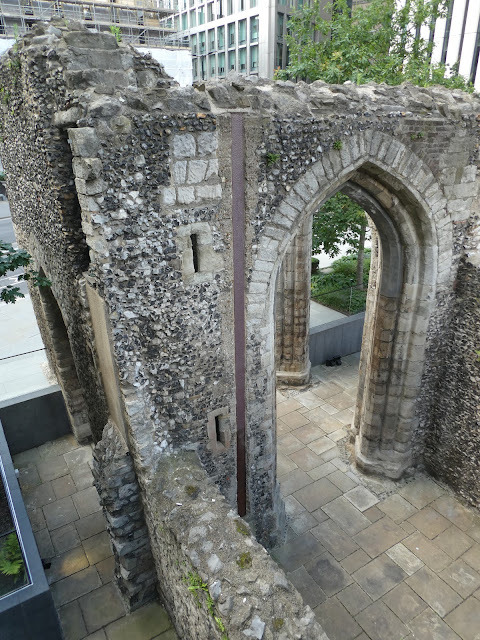








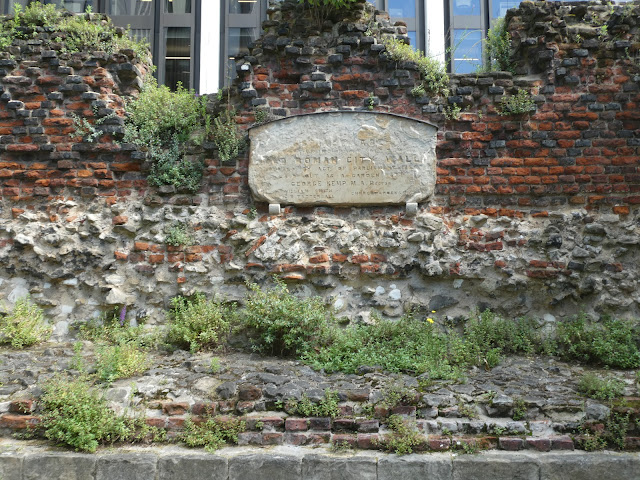

















































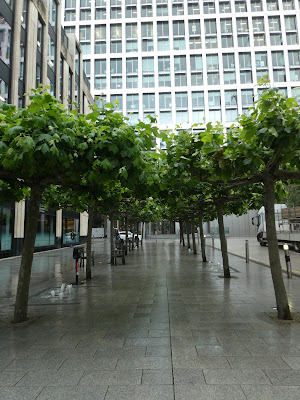






























































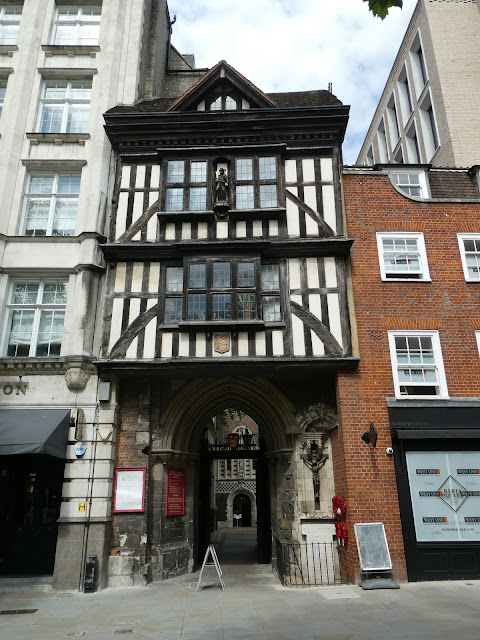

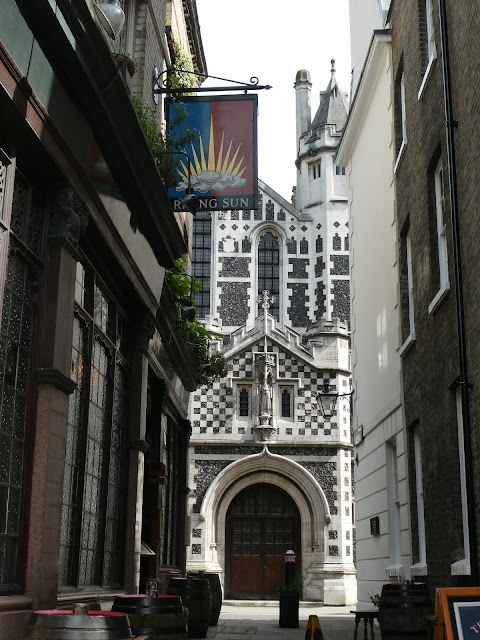

No comments:
Post a Comment